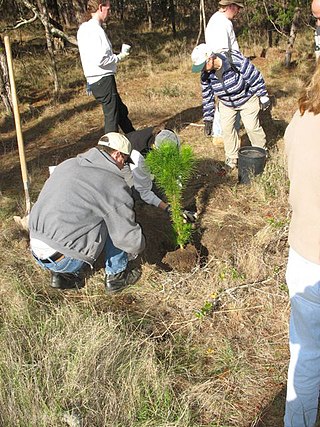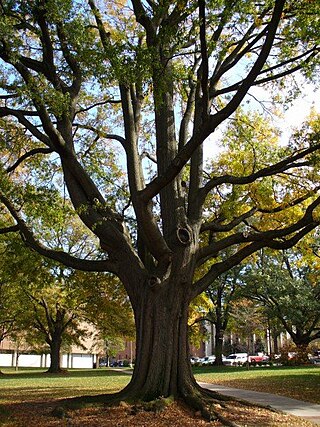
Forestry is the science and craft of creating, managing, planting, using, conserving and repairing forests and woodlands for associated resources for human and environmental benefits. Forestry is practiced in plantations and natural stands. The science of forestry has elements that belong to the biological, physical, social, political and managerial sciences. Forest management plays an essential role in the creation and modification of habitats and affects ecosystem services provisioning.

The Arbor Day Foundation is an American 501(c)(3) nonprofit membership organization dedicated to planting trees. The Arbor Day Foundation has more than one million members and has planted more than 500 million trees in neighborhoods, communities, cities and forests throughout the world. The Foundation's stated mission is "to inspire people to plant, nurture, and celebrate trees."

Urban forestry is the care and management of single trees and tree populations in urban settings for the purpose of improving the urban environment. Urban forestry involves both planning and management, including the programming of care and maintenance operations of the urban forest. Urban forestry advocates the role of trees as a critical part of the urban infrastructure. Urban foresters plant and maintain trees, support appropriate tree and forest preservation, conduct research and promote the many benefits trees provide. Urban forestry is practiced by municipal and commercial arborists, municipal and utility foresters, environmental policymakers, city planners, consultants, educators, researchers and community activists.
Articles on forestry topics include:.

An urban forest is a forest, or a collection of trees, that grow within a city, town or a suburb. In a wider sense, it may include any kind of woody plant vegetation growing in and around human settlements. As opposed to a forest park, whose ecosystems are also inherited from wilderness leftovers, urban forests often lack amenities like public bathrooms, paved paths, or sometimes clear borders which are distinct features of parks. Care and management of urban forests is called urban forestry. Urban forests can be privately and publicly owned. Some municipal forests may be located outside of the town or city to which they belong.
American Forests is a 501(c)(3) non-profit conservation organization, established in 1875, and dedicated to protecting and restoring healthy forest ecosystems. The current headquarters are in Washington, D.C.

Tree Line USA is a program sponsored by the Arbor Day Foundation in cooperation with the National Association of State Foresters which recognizes public and private utilities across the United States that demonstrate best practices that protect and enhance America's urban forests.

TreePeople is an educational and training environmental advocacy organization based in Los Angeles, California. The TreePeople organization advocates and works to support sustainable urban ecosystems in the Greater Los Angeles area through education, volunteer community-based action, and advocacy.
The following outline is provided as an overview of and guide to forestry:

A tree inventory is the gathering of accurate information on the health and diversity of a community forest.

The Monterey County reforestation refers to efforts in Monterey County, California, to preserve the county's pine forests and urban environment. This one county boasts the native Monterey Pine ecosystem; one of the rarest forest ecosystems in the world. Only a few thousand acres of these endemic trees exist in four locations along the Pacific Ocean on the Central Coast of California. The city of Monterey itself maintains more than 19,000 trees in parks and along streets, as well as about 300 acres (1.2 km2) of Monterey Pine forests.

Brad Stewart Lancaster is an expert in the field of rainwater harvesting and water management, sun & shade harvesting and community-stewarded native food forestry. He is also a permaculture teacher, designer, consultant, live storyteller and co-founder of the Dunbar/Spring Neighborhood Foresters, and Desert Harvesters, both non-profit organizations.

The Nebraska Forest Service is the state forestry agency for the state of Nebraska. The Nebraska Forest Service serves the citizens on Nebraska by operating with the mission to provide services and education to the people of Nebraska for the protection, utilization and enhancement of the State's tree, forest and other natural resources. Headquartered in Lincoln, Nebraska, the Nebraska Forest Service is embedded within the Institution of Agriculture and Natural Resources at the University of Nebraska-Lincoln.

The city of Atlanta, Georgia has a reputation as the "city in a forest" due to its abundance of trees, uncommon among major cities. Tree coverage was estimated at 47.9% for 2008, in a 2014 study.

Urban reforestation is the practice of planting trees, typically on a large scale, in urban environments. It may also include urban horticulture and urban farming.

Tree Canada is a non-profit charitable organization that promotes the planting and nurturing of trees in Canada's urban and rural areas. It provides tree-related education, technical assistance and resources to communities, corporations, individuals and non-profit organizations.

The Greening of Detroit is a 501(c)(3) non-profit environmental organization whose mission is to inspire the sustainable growth of a healthy urban community through trees, green spaces, healthy living, education, training and job opportunities. The Greening serves communities in Detroit, Highland Park and Hamtramck, Michigan.
Openlands is a non-profit conservation organization and accredited land trust that works with groups and individuals in northeastern Illinois, northwestern Indiana, and southeastern Wisconsin to preserve open space, develop walking and biking trails, restore natural areas, and connect people to the outdoors. Openlands has protected and expanded public access to more than 55,000 acres of land for parks, forest preserves, land and water greenway corridors, and urban gardens across the Chicago metropolitan region. It is a member of Chicago Wilderness.

Tree care is the application of arboricultural methods like pruning, trimming, and felling/thinning in built environments. Road verge, greenways, backyard and park woody vegetation are at the center of attention for the tree care industry. Landscape architecture and urban forestry also set high demands on professional tree care. High safety standards against the dangers of tree care have helped the industry evolve. Especially felling in space-limited environments poses significant risks: the vicinity of power or telephone lines, insufficient protective gear and narrow felling zones with endangered nearby buildings, parking cars, etc.. The required equipment and experience usually transcends private means and is often considered too costly as a permanent part of the public infrastructure. In singular cases, traditional tools like handsaws may suffice, but large-scale tree care usually calls for heavy machinery like cranes, bucket trucks, harvesters, and woodchippers.
Lissa Ann Martinez is an American ocean engineer and consultant from San Antonio, Texas. During her career, she has worked on policy-based solutions for environmental challenges. Following her graduation from the Massachusetts Institute of Technology (MIT), Martinez worked as a federal employee for the US Maritime Administration and the US Coast Guard. Her focus was shipping-related pollution control, maritime health, and safety. Martinez has also worked for the National Research Council and was on MIT's board of trustees. In San Antonio, she has been involved with urban forestry initiatives.













